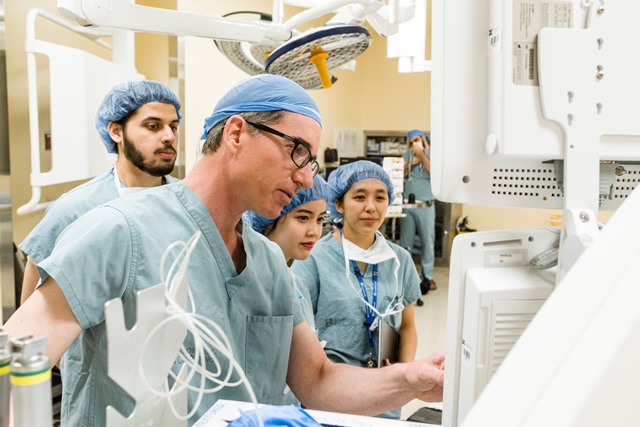
By Katherine Nazimek
It was 1949, and in the basement of Toronto’s Banting Institute, cardiac surgeons Drs. Wilfred Bigelow and John Callaghan were testing whether drastically cooling the body of a dog would make it possible to perform open-heart surgery. But during the procedure, the dog’s heart unexpectedly stopped.
Desperate to revive the animal, Dr. Bigelow “gave the left ventricle a good poke” with his forceps, he says in his autobiography Cold Hearts: The Story of Hypothermia and the Pacemaker in Heart Surgery. The heart responded but then returned to a standstill. So, he “poked it regularly every second.”
The action that he says “resembled a normal beating heart,” jolted the heart back to life but also sparked an idea: perhaps electrical pulses can have the same impact as his manual poke.
With help from the National Research Council in Ottawa, the surgeons recruited Winnipeg-born engineer John “Jack” Hopps to create a machine that would make their idea a reality.
The electrical stimulator – known as a pacemaker – resembled an old-time mantel radio with dials to control the heart rate and voltage, and catheters that fed electrodes through the arteries to the heart.
Now much smaller and implantable, pacemakers have since saved millions of lives, including that of the man who invented it.
THE CURRENT REALITY
Medical technology (medtech) plays an important role in modern health care.
Patients are benefitting from more targeted, less invasive treatments with shorter recovery times. Hospitals see better treatment outcomes, shortened length of stay, and reduced costs that inevitably could contribute to sustaining our health system.
But Canada is lagging. In 2016, Canada’s medical technology market sat at an estimated US$6.7-billion in a US$336-billion global market.
“Canada is home to world leaders on the scientific front, physicians who do high procedural volumes and complex cases, and strong clinical research capabilities,” says Dr. Brian Courtney, an interventional cardiologist at Sunnybrook Health Sciences Centre who earned his engineering degree before attending medical school. “And yet, when we go and use devices, they’re often sourced from elsewhere, not Canada.”
Jack Hopps was in no rush to patent the idea of the pacemaker and it became one in a list of successful inventions – like the lightbulb and the zipper – that was invented by Canadians but commercialized elsewhere. This means that the rights and associated profits went elsewhere too.
Canada imported $8.6-billion in medical devices in 2016 and exported only $3.1-billion, according to Statistics Canada – a trade gap of $5.5-billion. And with an aging population and increased health awareness, the world market is projected to grow.
While many Canadians have the ability to innovate, industry leaders say few have the skills necessary to take a medical device from idea to invention through commercialization. As a result, and more heartbreaking than its impact on our economy, many promising medical technologies may never reach the patient bedside.
FILLING THE GAP
The Schulich Heart Program at Sunnybrook Health Sciences Centre has taken the lead to address this skills gap and nurture a generation of medtech professionals by launching a hospital-based education program called Medventions.
The Medventions’ mandate is two-fold: pave the way for new waves of medical technology that are directly targeted at unmet clinical needs; and mentor scientists, clinicians, and engineers in the complexities of bringing their innovations from bench to bedside.
Over a four-month fellowship program, a small group of clinicians, engineers and business graduates undergoes entrepreneurial training while being immersed in a clinical setting.
Just like the pacemaker, many ideas emerge from challenges seen on the frontline. Medventions team members – side-by-side with health-care professionals – see with their own eyes the daily challenges that are faced.
Similarly, healthcare professionals who are working with fresh sets of eyes and being armed with new knowledge of the commercialization process, begin looking at their challenges as ones that can be fixed.
When the program first launched last fall, the inaugural group of engineers, scientists and clinicians came together to solve a common problem faced by cardiologists worldwide: how to better image and fix blocked blood vessels.
The team worked with academic and industry advisors to devise a solution, build a prototype, and plan the steps necessary to commercialize a product – from protecting intellectual property to manufacturing. They are now in the process of obtaining a patent for a device that could potentially improve patient outcomes and also save hospitals money.
“The idea is just the beginning,” explains Graham Wright, research director of the Schulich Heart Research Program. “Bringing a device to market is a lengthy process that involves building prototypes, protecting intellectual property, acquiring financing, manufacturing, obtaining regulatory approvals, and performing studies before reaching the bedside.”
It’s a process that can take upwards of 10 years. But the Medventions program provides innovators with the tools they need to get started.
“Our hope is that participants can then apply their talent to drive innovation in organizations; lead research projects; or build their own start-ups,” says Dr. Courtney, also the founder of Conavi Medical Inc. “And do this all with the mindset of improving patient care, and using our health-care resources more effectively.”
For more info about Medventions, visit sunnybrook.ca/medventions
Katherine Nazimek is a Communications Advisor at Sunnybrook Health Sciences Centre.

